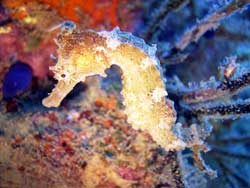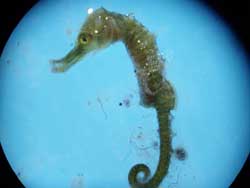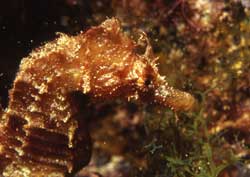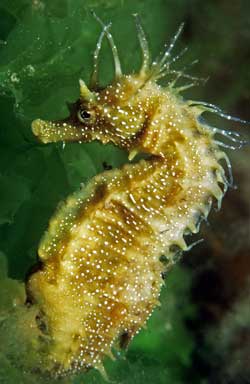Seahorses: a race against habitat destruction
Of all the strange creatures that inhabit our oceans, seahorses are one of the most unique and mysterious. These tiny fish are among the few kinds that swim upright, winding their curly tails around plants to help anchor them against the current. Instead of scales, they have bony plates under their skin, and use their long snouts to feed on plankton. Most curious of all? In these gender-bending animals, males become pregnant – carrying fertilized eggs in their belly pouches, and nurturing and protecting their young as they grow.
 Fishing for Seahorses
Fishing for Seahorses
Unfortunately, there´s a huge human appetite for these cute animals. You might be wondering how anyone could find these bony creatures appetizing. In fact, they are mostly used for medicinal purposes in China, Japan and Korea, as they are believed to treat asthma, sexual dysfunctions, pain, and other ailments. The demand for seahorses has exploded in the past few decades, mirroring China´s economic growth.
Fisheries all over the world supply this demand, with seahorses that are either targeted directly, or captured unintentionally (as bycatch) in bottom-trawl fisheries. Bycatch makes up the majority of international trade. By 2001, at least 25 million seahorses were traded by 77 countries – more than 70 tonnes! Seahorses are also popular in aquariums and are sold as souvenirs (and sometimes even snacks) around the world.
Seahorses are threatened by more than just fishing. They commonly live in seagrass beds, mangroves, and coral reefs in coastal shallow waters, which are all highly sensitive to pollution, climate change and other human impacts. For example, the Deepwater Horizon oil spill in the Gulf of Mexico in 2010 destroyed seagrass beds, driving down populations of an already-threatened pygmy seahorse species that inhabits the area. Seahorses are especially vulnerable to disturbances, as they are slow swimmers are sparsely populated throughout the oceans, and are monogamous, remaining faithful to their mate. All of these factors meant that if one of a pair disappears, its mate is very slow to find a new partner.
 International Trade
International Trade
The Convention on the International Trade of Endangered Species (CITES) lists all seahorse species on its Appendix II, recognising that they may become threatened with extinction unless trade is closely controlled. In order to trade seahorses internationally, countries who have signed the CITES agreement must control and monitor exports, granting export permits only where it is clear that trade does not threaten wild seahorse populations. Nevertheless, illegal harvesting and trade occurs, and several countries have opted out of the CITES agreement. In January 2010, 25,000 seahorses were seized from a warehouse in Peru, which belonged to a Chinese citizen who had planned to export them to Japan via Hong Kong. Only a month later in Panama, 20,000 seahorses were discovered hidden inside the stomach of a fish from Peru.
 An enigmatic species
An enigmatic species
Current research, combined with customs and trade records, shows that seahorse populations have undergone rapid declines. Fishermen and divers have also reported the disappearance of seahorses from coastal areas. However, there are still many unanswered questions, as seahorses are very difficult to study in the wild. How many are there in the oceans? How many species are yet to be discovered? How does their unusual mating system work?
By managing our oceans more wisely, we may be able to find the answers to the above. One thing is clear: strong and thriving populations of seahorses are probably good indicators of healthy oceans and habitats for a multitude of other marine animals. Where seahorse populations are known to have declined, we should pay close attention to the reasons why – and make every effort to reduce the threats to these intriguing creatures.
 Fascinating Seahorse Facts
Fascinating Seahorse Facts
Seahorses have no teeth or stomach, but they use their long snouts to suck up crustaceans and other zooplankton.
The smallest seahorse is a pygmy seahorse species (Hippocampus denise), and, at 16 mm long, is smaller than most fingernails! Other adult seahorses can reach lengths of 35 cm.
Seahorses aren´t great at swimming. Like chameleons, they rely on their camouflage to hide from predators. The leafy sea dragon, a close relative of seahorses, has one of the most impressive camouflage capabilities.
Also like chameleons, seahorse eyes can move independently of each other.
Adults live one to three years, and only a few eggs out of a brood of up to 2000 survive when released from their father’s pouch

